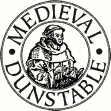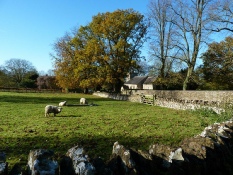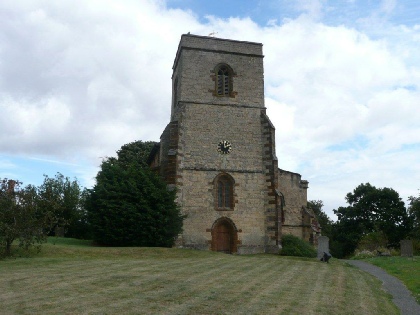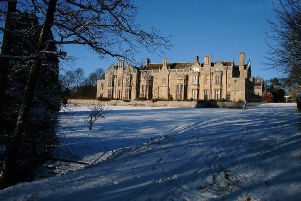
Medieval Dunstable© Webmaster Helen Mortimer Privacy Policy | Terms of Use



Churches and Lands
Northamptonshire
Click this link for an interactive map of the counties, towns and villages.
Newbottle, Charlton and Purston, Northants
St James Church, Newbottle; by Canon Michael Hayter
The road here goes no further – stop, and look
Across its mown-grass verge and dry-stone wall
To see Saint James’s church. Its square stone tower
Has stood here for eight hundred years or more,
The nave and chancel for a hundred less.
All’s country made, and unspectacular,
But fully fit to be a house of prayer.
The churchyard, closed a hundred years ago,
Is filled with lichened gravestones, and enclosed
By oak, horse chestnut and a copper beech.
Its gates embowered in an arch of yew,
Its grass kept short by being grazed with sheep,
In spring the snowdrops, then the daffodils,
Emblazon either end;return each year
Their promise of new life again fulfilled.
***
Behind the church still stands its manor house
It’s old, but younger by four hundred years –
With garden, barns, a dovecote and a view
Across the Cherwell valley to the west.
Around these, once a fair sized village stood,
But now the one-time vicarage, one house,
And woods and fields are all there is to see.
***
Eight centuries ago, the first stone church,
(There must have been a wooden one before)
Was built by William Pinu to fulfil
A bargain made by him with Dunstable,
And with his brother Morin, who was heir
To Newbottle’s estate. For Morin was
Ordained a priest and later, was professed
A canon by the Prior of Dunstable
This meant he must no longer hold his lands,
But yield them, as the rule of poverty commands.
The bargain was that William should succeed,
To hold the manor in his brother’s place,
And in return should build a parish church;
Then hand it over for the monks to hold,
To be its Rector and receive its tithes,
And choose a priest to serve its people’s needs.
This then was done; de Pinu built his church
With stone he quarried from his own domain.
The church was simple and less grand
Than those of other settlements nearby,
But did fulfil the bargain that he’d made,
While next door Charlton had no church at all!
***
A hundred years passed by. The Priory now
Held lands in Charlton; and Newbottle, still
A fair sized village, thought the time was come
To build again upon an ampler plan.
They kept the tower, but built the rest anew
The church they built is what we see here now.
Newbottle’s land,while owned by Lord de Grey,
Was next enclosed with fields, to pasture sheep.
The need for men to till the ground grew less.
Their occupations gone, their homes destroyed,
Men left the land, the population shrank.
Newbottle’s township started its decay,
A wastage that has lasted to this day.
Its neighbour, Charlton, had no single lord
To form a parish and to build a church,
Nor had the power to enclose its fields
Though poor, its population stayed intact,
And kept the numbers that Newbottle lacked,
To use Saint James’s church and keep it filled
Go through the porch, unlatch the door, walk in
And meet an atmosphere of hallowed quiet.
The building’s very old, but still keeps sound,
Repaired and cared for, even though
The numbers who attend it are much less
Than those who thronged it sixty years ago.
Look round – and see the furnishings of faith:
A font and altar, for the Sacraments;
A lectern and a pulpit for the Word;
And all the nave filled up with rows of pews,
Replete with bright embroidered kneelers, and
A long blue carpet down the centre aisle.
Each Sunday brings Saint James a pilgrimage
Of worshippers, who come by car, or walk
A mile along the tarmacked path which links
Newbottle church with Charlton’s burial ground.
Most are from churchless Charlton, but some too
From villages around, attracted by
The simpleness and seemliness,
The peace and air of prayerfulness
That in this place are found
Reproduced by kind permission of Canon Hayter’s family.

Newbottle
Newbottle

Newbottle

Author Jean Yates
The story of Dunstable is told above, but we can add a few details from Dunstable’s Charters and Annals. Somewhere between 1148 and 1166 the church is granted to Dunstable, and was dedicated in 1231. There are charters concerning land in all three places, Newbottle, Charlton and Prestona. One gift of land in Charlton is of 1 hide (approx.120 acres).
The same donors, the de Pinu family,also gave Dunstable a large manor in Cadeby, Leicestershire. This was in Charters 248-50; 1131-1141, Morinus de Pinu ‘gave the land at Catebi’ (Cadeby). . because (the canons) have received him into their fellowship by the counsel of his (over)lord The Count of Meulan’.
There is a particular mention of Gilbert of Hida granting a virgate (30acres) in Charlton with a house and garden near the chapel of St. James, 1210/1240.Alanus is a son of Gilbert. Could it be the same family when Dominus Alanus de Hid and Alicia his wife in 1240 fund a chaplain, canon or secular, to minister in their chapel at Hyda.
A Charter c1190, states that ‘Jordan de Humaz and Hathewisa his wife confirm the church of Neubtl’ and a messuage in the south field as large as that which the Prior demised to him in Neubotl’. The Prior quitclaimed one virgate in Cherletona, another in Neubotl’, a third in Prestona; and granted that a mass should be said on Sundays in his chapel of Prestona.’
Another charter refers to a manse in Charlton. In 1256 the Prior reserves the income from lands, meadows and mill and other lands of Newbottle church when he rents out land worth three and a half marks a year.
In 1245 in the annals, we are told that Vivian gives us back his farm and the details of the animals that the Priory then put on it. In 1283 a new hall was built at Newbottle.
In the charters it states that Hugo of Chenei (dut) exchanges 150 acres of land in Cheinedut and Seibroc with land in Charlton, and another that mentions tenants in Seybrok. In 1256 land is rented out to John Cheydut., but the Priory kept two granges and the old hall. A fight in the High Street between John Boyver and Sir William Cheydut is detailed in the annals.
There is a charter dated 1218/1233 when Roger Alebol of St Ebrulf (St Evroul) granted tithes and land in Great Brickhill, Shenley and Newbottle. Dunstable paid those tithes to Ware Priory a cell of St Evroul
It is possible that Dunstable rented more land at Newbottle from St Evroul. Although a note from the editor of the charters states ‘The tithes of Newbottle ….. were given to St Evroul by Osborn son of Teszo’.
Is it possible that the tithes had been given away before Morinus de Pinu gave himself and his lands to Dunstable but in 1540, the Court of Augmentation records all of the following under Dunstable;
Rectory of Newbottle; Pet. Dormer farm of complete Rectory of Newbotell with all tithes of sheaves, grain & hay ptg. to sd. Rectory & also with tithes of [illegible] situated in Charlton, Northants. & 1 dovecote ptg. to sd. Rectory by ind. dated in sd. chapter house of Dunstable 25 Oct. Henry VIII [1533] for 31 yrs. Repairs & all charges at expense of farmer, great timber & slates excepted.
value 66s.8d.
Lands and Tenements in Cokyslandes with other lands called Panyslandes in fields of Charlton Northants
Pet. Dormer farm of all these lands and tenements, meadows, pastures and herbage called Cokyslande and 1 croft and dovecote adjacent also all those lands and tenements meadows, pasture and herbage called Panyslande lying dispersedly in fields of Charlton dated at Dunstable in chapter house 25 Oct. Henry VIII [1533] for 33 yrs. Value 26s 8d
References;
Dunstable Annals, David Preest 2013, Boydell and Brewer
Charters of Dunstable Priory, Beds Historical Record Society,(BHRS) Vol. IX
Court of Augmentation Accounts for Beds. BHRS Vol 63 & 64
Pattishall

Pattishall, Cold Higham, Ascote & Grimscote, Northants - Jean Yates
In 1066 4 close relations, standard bearers of William, from Flanders were given most of the ‘high points’ of Bedfordshire. They built a castle at Odell and were involved in Totternhoe and Segenhoe Churches. The family name became Wahull.
Walter de Wahull (Odell), of Patheshull, Hecham(Higham) and Grimscot, rendered himself to the church of St Peter, Dunstable, a moiety (half) of the church of Pateshull, a moiety of the church at Hecham and all his land at Grimscot.
During the reign of King Stephen, 1139-54, Simon de Wahull granted half the church in Pattishall to the nuns of Godstow Abbey near Oxford. His son, Walter, granted the other half (which included half the main tithes) to the priory in Dunstable, during the reign of Henry II, 1154-89.
The Dunstable Charters tell us that with half of Patheshull church came three and a half virgates of land, which is 105 acres.
In 1217, Hugh II - of Wells - Bishop of Lincoln confirmed these arrangements and the provision of two clergy houses, one for each. (1)
1202-17 Simon of Pattishall received land from the Prior of Dunstable, in return for which he was ‘to find for the prior fitting entertainment (lodgings), three times a year, if he comes with four horses, or twice a year if he comes with six horses’. (3)
In 1230, permission was given (by Dunstable) to build a chapel and have a chantry in the manor of Auescote in the parish of Pateshull.
The annals tell us that Dunstable Priory had a farm at Grimscote, and built a hostel for servants at Pattishall in the 1200s.(4)
The Dunstable house was originally a rectory but later became called a vicarage. Pattishall was served by two clergy in one church. This continued after the Dissolution. The Dunstable vicarage still stands to the west of the church, a thatched cottage in Church Lane.
The north side of the Sanctuary contains the John Gilling aumbry, given in 1349. Gilling was presented by Dunstable Priory in 1317, by John of Cheddington.
The parish of Pattishall consisted, then as now, of Pattishall, Fosters Booth, Eastcote, Dalscote, Cold Higham and Grimscote. (2)
In 'Calendars of Inquisition and Post Mortem': - 'Katharine, late wife of Robert of Todenham (Toddington), died 8th June 6 Ri II (1383) John de Todenham aged 30 son & heir.'
Inquisition held at Northampton included 'Grymmescote, 8 messuages and 7 virgates of land held of the prior of Dunstable by service of maintaining the prior with his men, horses and hounds twice a year for as long as the prior shall be please to stay there with his men etc on his way from Dunstable to a certain manor of his in the county of Derby and on his way back to Dunstable and a watermill held of the same prior by the same service.'
In 1535, Valor Eccliasticus, Henry VIII’s valuation of the monasteries, valued Patyshull at 113s 4d, Coldehygham 11s, and Grymscote at £4 12s.
References;
1 George Baker’s History of Northamptonshire, vol III pp286/7 and 295/6.
2 Holy Cross and Pattishall booklet
3 Dunstable Charters (BHRS IX)
4 Dunstable Annals Preest (2013)
Rushton Hall c1750

St Peter Rushton Hall, Northants - Jean Yates
Dunstable Priory Charters tell us that ‘c1242, Willelmus Basset grants the patronage of Ruschinden, and wills to be buried with the canons’. The notes state ‘the final concord for the advowson of Rushton co. Northants is recorded as made in 1241’.
The Annals tell us that this gift was in 1241 and Robert Rotelond was offered as parson to the church. He was there until his death some thirty years later when Robert of Scarborough was presented by the Priory. Six years later he was followed by his nephew John.
In fact the Parish records indicate the institution of a rector at St Peter’s before 1219. (1)
St. Peter’s church near the manor house on the south side had a nave, north aisle and chancel, with a low tower at the west end with one bell. It was a parish church and a private chapel for the family of the Lords of the Manor.
The earliest known Lords of this manor were the Bassets. These were followed by the Penythorne, Tresham and Cokayne families.
The Treshams came to Rushton when William married Isabella Vaux of Harrowden. He was MP for Northamptonshire, Speaker of the House of Commons and a Lancastrian. He became patron of St Peter’s in 1437. He was murdered in 1450, His son Sir Thomas was put to death by Edward IV after the battle of Tewkesbury. This Thomas’ son John was restored to his estates, and rebuilt Rushton Hall in the early years of Henry VIII’s reign.
His son Sir Thomas became Lord Prior of the Hospitallers and died in 1559. He was succeeded by his grandson Thomas who was the builder of the Triangular Lodge, Lyveden and considerably altered Rushton Hall. This last Thomas was succeeded by his eldest son who was involved in the gunpowder plot and died in the Tower. (2)
Rushton St Peter and Rushton village church of All Saints were amalgamated in 1780 and St Peter’s was demolished in 1799 along with its rectory. This demolition enabled All Saints to be refurbished with money and materials from St Peters. Also transferred was a bell, cast in 1593 and with an inscription of Come Come and Prea and a Tresham tomb.(1)
It is not recorded when Dunstable lost Rushton, there is certainly no trace of it in the valuation records of 1535. The annals and charters survive for 1200-1300 and we must assume therefore that it was after 1300, possibly when a change of the Lord of the Manor occurred.
The engraving of Rushton Hall was made in 1750 and clearly shows St. Peter’s church as well as a number of other buildings that have long since disappeared, although the main four wings of the Hall around a quadrangle remain very much the same today.
For approximately fifty years after World War II, the Hall was owned by the R.N.I.B. and was used as a school. During this time I was fortunate to be allowed over a period of ten years, to run caravan rallies in the grounds and support the school. The prints of William Winstanley’s East Prospect of Rushton, made for Viscount Cullen were sold to raise money for the school and having enjoyed a tour of the house and of All Saints church, given by the head gardener and his wife, I bought one.
When we started this project I had no idea that I would uncover a link between Dunstable and Rushton Hall, a place that I got to know so well and love. And, without this knowledge I doubt that I would have made the connection between Rushinden and Rushton.
Rushton Hall is now a hotel.
References
1 All Saints church Rushton Guide
2 The Parish Church of All Saints Rushton, Historical Notes compiled by Sir Gyles Isham Bt., F.S.A.
Dunstable Priory Charters, Beds Historical Record Society BHRS Vol IX
Dunstable Annals, Preest 2013, Boydell and Brewer
Rushton Hall

Weedon Bec - Jean Yates
I am indebted to Mike Rumbold of the Weedon Bec History Society. When I wrote to him about Dunstable’s connection with Weedon Bec, it prompted him to do some research.
The village had always considered that the name Bec came from the fact that a few years after the Norman Invasion, the owners of the two manors here, on separate occasions, gave them to the Abbey of Bec, in Normandy. It had therefore been assumed that the Advowson was also held by Bec, but without any hard evidence.
Henry VIII’s valuation of the monasteries, Valor Ecclesiasticus in 1535 firmly places Weedon Bec under Dunstable.
The noted county historian John Bridges.(1791) wrote:-
This church was very early appropriated to the Monastery of Bec in Normandy, and in all probability was given to that Convent by Roger de Thebovill, when he bestowed upon it the moiety of the Manor. . .
In 1535, 26 Hen VIII. The rectory was let for xii l. by the Prior of Dunstaple, who was then the impropriator, and the vicarage valued at xi l. iii s. out of which was allowed iii s. for synodals and procurations. The present impropriator and patron is Mr Thornton of Brockhole. [now known as Brockhall]
John Leland wrote; ‘A litle from the south side of the chirch yarde ys a faire chapel dedicate to S. Werburge, that sum tyme was a nunne at Wedon.’
Also mentioned in Valor, along with the church is Wedunbek Cant. which presumably is the chapel Leland saw above. Thomas Crokey was the capellan here in 1535. The incumbent vicar at the church was Robertus Gostwyck.
Mike says ‘before the canal embankment obscured the church from the main road (Watling Street, A5) this chapel might have been the first building a traveller would encounter on reaching the village; a perfect site for a chapel provided to minister to travellers. The next two buildings were pubs!’
Between these two events:- In 1414, Henry V took over several ‘Alien Priories’, including Weedon; this he granted, in 1437-8, to Humphrey, Earl of Stafford, until he was killed in the Battle of Northampton (1460).
We have some confusion at this period between Victorian historians which needs more research. The advowson it is claimed went to Eton College in about 1420. I do not think this can be right if Dunstable held it in 1535.
One possible explanation for the confusion is that the church and the chapel had two different patrons. There is no mention of Weedon in the Charters or Annals of Dunstable, but these exist only for the years 1200-1300. The mystery of Weedon Bec is still to be resolved.
| Archaeology |
| Audio Guides |
| Education |
| Exhibitions |
| Events 2013 |
| Physic Garden |
| Priory History |
| Priory Churches / Lands |
| Town History |
| Virtual Tour |
| Website |
| Archaeology |
| Charters & Bylaws |
| Eleanor Cross |
| Famous People |
| The Fraternity |
| Friary |
| Guided Tours |
| History |
| Inns |
| Dunstable Treasures |
| Kingsbury |
| Middle Row |
| Royal Visits |
| Sheep & Wool Trade |
| The Town |
| Friary Archaeology |
| Bone Study |
| Friary |
| Annals Charters Valor Ecc |
| Archaeology |
| Churches and Lands |
| Guided Visits |
| Audio Guides |
| History |
| Monastic Life |
| Virtual Tour |
| The Augustinian Priory |
| The Canons Route |
| Bedfordshire |
| Buckingham |
| Derbyshire |
| Nothamptonshire |
| Hertfordshire |
| Leicestershire |
| Oxon |
| Priors |
| Annulment |
| History |
| Archives |
| Book Sales & Shop |
| Exhibitions |
| Guided Walks |
| Heritage Talks |
| Physic Gardens |
| Schools |
| Tourist Information Centre |
| Tea-room |
| Visits |
| Priory House Heritage Centre |
| Education |
| Knight |
| Search Results |